Art as a Family Affair—The Legacy of the Wyeths
Published with Permission
Written by Pat Knepley
www.TOSMagazine.com
No other family has had quite the impact on the twentieth century American art scene as have the Wyeths. N. C. Wyeth (Newell Convers Wyeth) the patriarch, was born in 1882 and studied art and drafting at the Mechanic Arts School in Boston and some other institutions in Massachusetts. In 1902 he traveled to the Philadelphia suburb of Chadds Ford, Pennsylvania, to study with the great Father of Illustration, Howard Pyle. N.C. stayed in Chadds Ford for the remainder of his life, dividing his time between his home there and a vacation home in Maine.
N.C., who was called Convers by friends, followed in his teacher’s footsteps to become one of our country’s greatest illustrators. Illustrators are those who create art for publication, such as for books, magazines, or in advertising. Illustrators are hired for a very specific project, called a commission, and one of N.C. Wyeth’s first commissions was to create a cover for the Saturday Evening Post, which in 1903 a very popular magazine.
N.C. Wyeth is probably best known for his amazing illustrations for classic children’s literature. His most important commission came in 1911 from Charles Scribner’s Sons publishing house, to illustrate Robert Louis Stevenson’s Treasure Island. After the enormous popularity of this first book, N.C. enjoyed a long career illustrating classics for Scribner’s as well as other publishers. To see some illustrations by N.C. Wyeth, visit this website. [http://www.bpib.com/illustrat/wyeth.htm] (more…)

